Why Is Food Safety Important In Healthcare? Healthcare Leaders Guide
Learn challenges healthcare foodservice teams face today and key food safety practices to protect vulnerable patients. Get a free healthcare leader...
Thawing requires adequate time and planning to protect the food from spoilage hazards.
Freezing foods is a very effective way to significantly extend the shelf-life of foods during storage. An operation that inevitably goes together with freezing is the thawing process.
It is almost impossible for food handlers to use frozen foods to prepare dishes. The unmanageable state of frozen foods requires thawing to make critical operations, such as cooking, effective.
However, thawing presents an opportunity for harmful bacteria and other pathogens to recover and cause food spoilage. Food handlers must learn which is an approved method of thawing frozen food.
Whenever possible, a correct way to thaw food is by placing it in a refrigerator at 40 °F or below so it can remain at a safe and consistent cold holding temperature.
In this article, learn which methods are approved for thawing foods and expose common myths.
WHAT WE'LL COVER:
Food thawing refers to the process of melting the ice crystals formed on food as a result of freezing. This operation requires higher temperatures to reverse the effects of freezing foods. Thawing is performed prior to cooking foods to make the cooking method effective.
Skipping the thawing process can lead to ineffective cooking, such as the center of the food not reaching the internal target temperature. This point can then result in the growth of bacteria and harm customers.
The main objective of thawing food is to melt the formed ice from freezing. Melting ice is done by placing the food at a higher temperature than the freezing point of water, which is 32°F (0°C). Because the rate of thawing ice is not equal throughout the food surface, some parts will thaw first before the rest. This point is an opportunity for foodborne bacteria to contaminate and spoil the food.
As such, thawing must be done in the fastest way possible or at a safe temperature using the correct equipment. Food handlers must always ensure that no part of the food will stay within the temperature danger zone for a prolonged period. This means that it is not advisable to leave frozen food at the counter or food preparation sink to thaw.
In addition to the surrounding temperature, time is also an important factor when thawing foods. Food handlers are always advised to thaw foods ahead of time inside a refrigerator, which is one of the safest methods. Rushing the process by cooking partially thawed food may cause uneven cooking and increase the risk of foodborne illness.
While cooking frozen foods is possible, the parameters for safe cooking will significantly vary. The food must be cooked more slowly and longer.
.png?width=680&height=1014&name=thawing_food%20(1).png)
There are three proper thawing procedures for frozen food, according to the food safety agencies: inside the refrigerator, using a microwave, and in cold water. These methods all precisely combine temperature control and thawing time. Their main safety control is that neither of the three methods allows the food to stay in the temperature danger zone for more than two hours.
Below, we explain the three approved methods for thawing frozen foods:
Thawing frozen food inside the refrigerator is the safest method. However, you must plan to ensure success. This method is recommended for thawing perishable foods such as raw meat and poultry.
Food handlers must estimate how long it would take to thaw foods at refrigerated temperatures. Some foods, especially large cuts of meat or blocks of food, will require 24 hours. Although you are raising the internal temperature of the food being thawed, the final target temperature, which is 40°F (4°C), is still considered safe.
Thawing food inside the refrigerator offers many advantages over other methods. This process can retain the freshness of thawed foods for more than a day, assuming it was not taken out after thawing. Additionally, foods thawed inside a refrigerator can be refrozen without the risk of contamination by bacteria and food spoilage.
To ensure food safety, your refrigerator must be kept at a constant temperature. Use our temperature log sheet to record your refrigerator temperature reading.
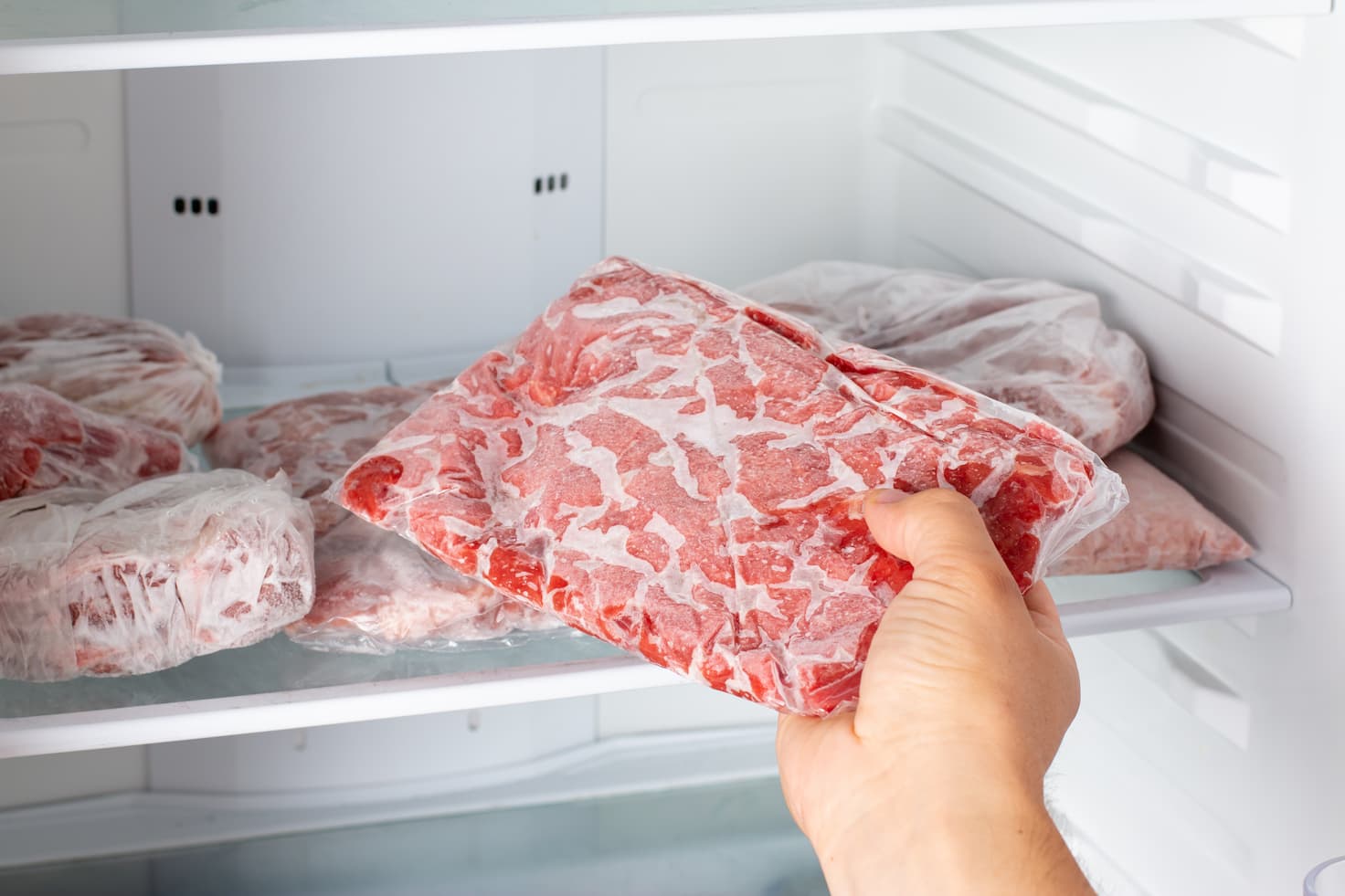
If you need a faster and safer defrosting method, you can thaw foods in cold water. Unlike thawing foods inside the refrigerator, submerging the food in cold potable water allows for a faster temperature change as the water coats the entire food.
However, the cold water thawing method requires a lot of attention and a few things to consider:
An alternative thawing process to submerging the contained food in cold water is thawing under cool running water. The process is quite similar. The food must be sealed in a leak-proof package and placed in a strainer or colander to hold the food item.
The disadvantage of using cold running water is that it is economically not sound and wasteful. Additionally, the bag is more prone to holes or openings if it is subjected to a continuously running flow of water.
Thawing foods using the microwave at a defrost setting yields fast but uneven results. Especially when the frozen food has an irregular shape, the microwave will not be able to apply heat evenly. Some parts may thaw faster than others, risking the thawed parts being cooked with further microwaving.
Microwave-thawed foods are recommended to be immediately cooked. Some parts of the thawed food will be exposed to the temperature danger zone, and potentially contaminating pathogens must be immediately eliminated.
If you are in a rush, microwave foods to thaw them. Exercise caution by monitoring the food being thawed.
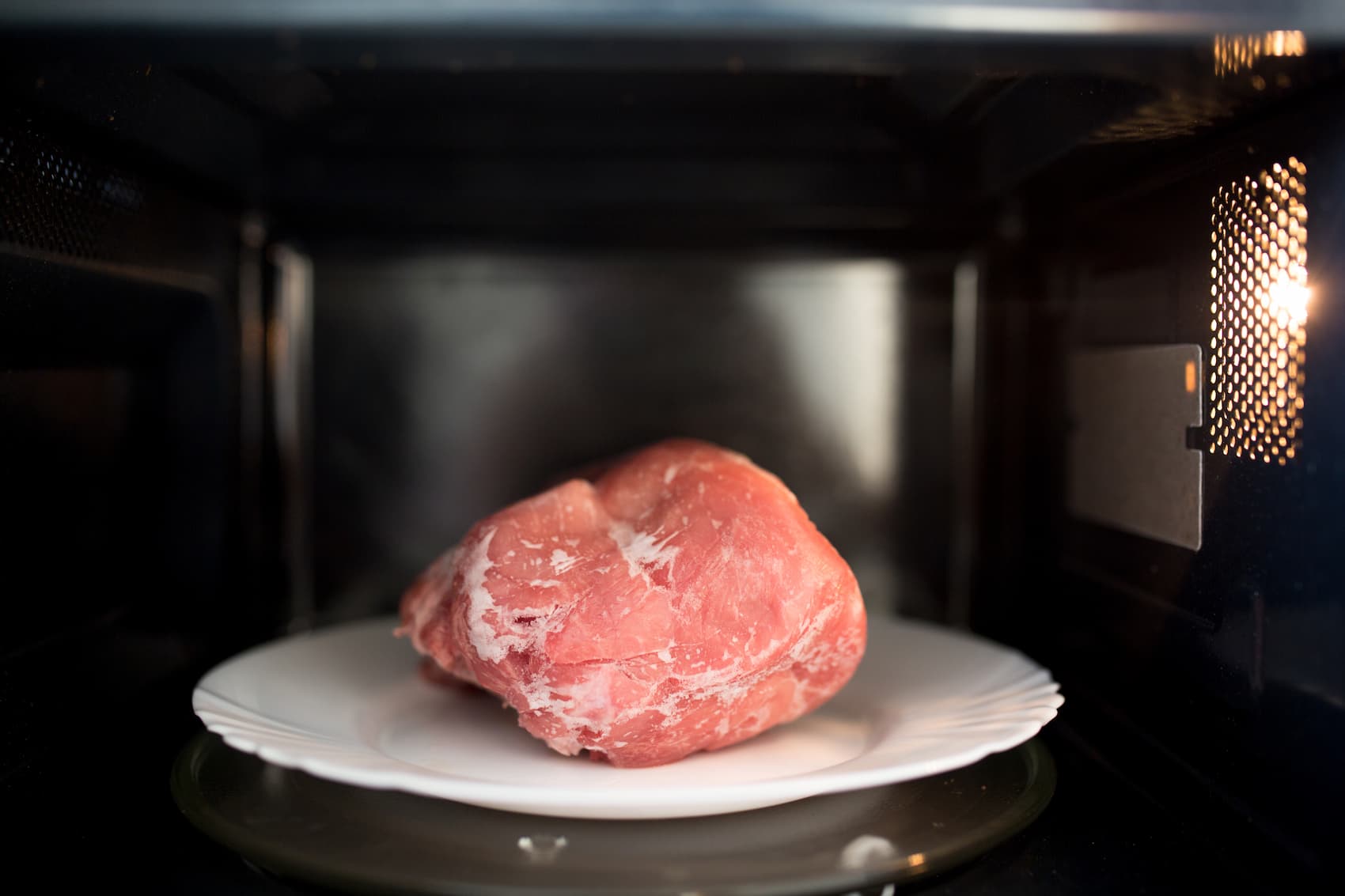
Some types of food can be thawed as they cook. The best example is burger patties and French fries. Because these foods are relatively thin, they can be cooked evenly.
This method is also advisable for foods that may lose shape once thawed. Cooking this type of food while thawing allows the outer surface to cook and solidify while the inside slowly reaches the correct temperature.
If you are in a hurry because you forgot to thaw your frozen common meat the day before preparing it, you may become very tempted to leave the food on the kitchen counter surfaces to thaw faster. While this process is undeniably faster and a more convenient method than thawing inside the refrigerator, it is not a safe method. You should never thaw food by leaving it on the countertop at room temperature.
As the food thaws at room or ambient air temperature, parts that have already thawed are exposed to the danger zone temperature range. At this point, any present foodborne illness-causing bacteria can further divide and spoil the food faster before it can be cooked.
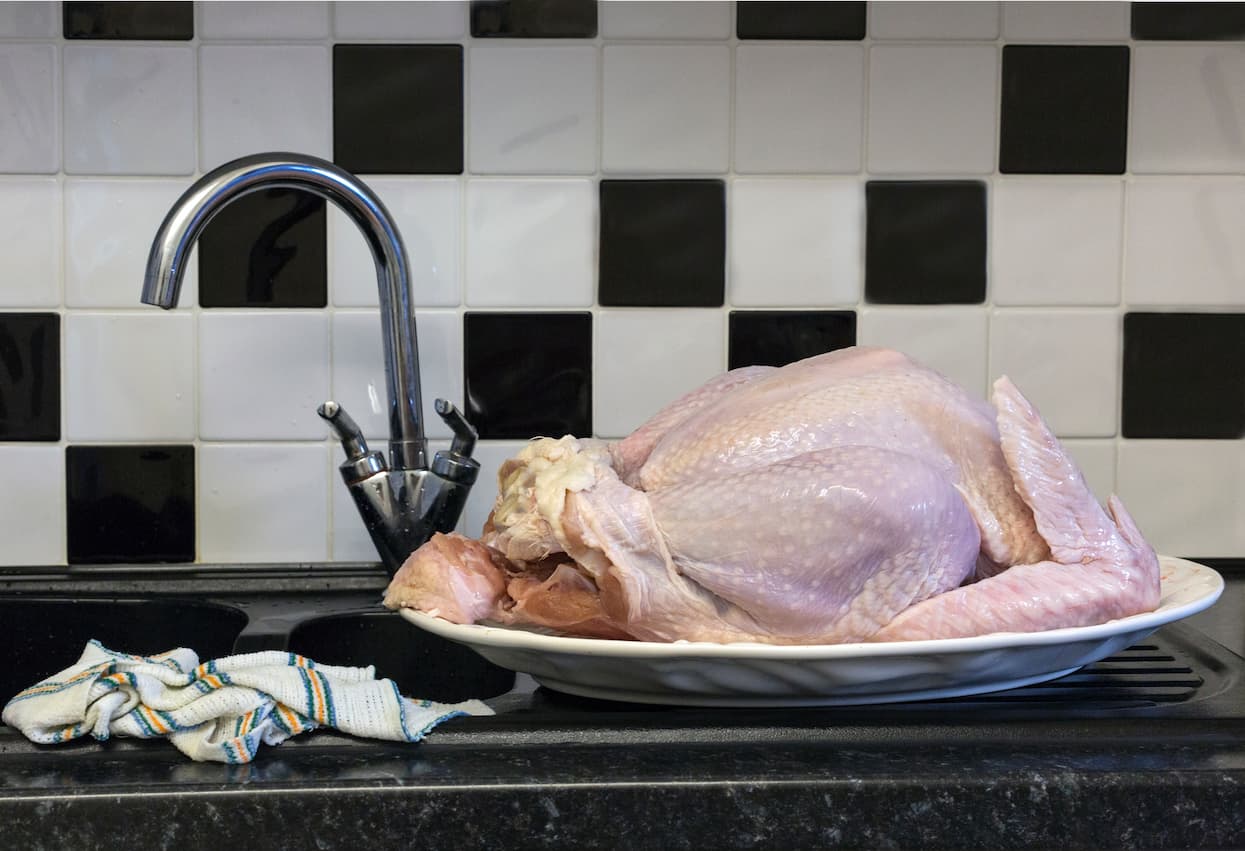
Depending on the circumstances, you may choose to thaw your foods inside the refrigerator, submerge them in cold water, or use a microwave oven. Some critical factors to consider include time, the type of food, and its size.
The best method when you have the time and plan ahead is to thaw foods inside the refrigerator. This process is the safest and guarantees no contamination from the process. Bigger cuts of meat or food require around 24 hours to thaw. Cuts of frozen chicken breasts will thaw faster than a whole turkey. Thawing inside the refrigerator also requires less monitoring, given that the refrigerator is working properly.
If you are in a hurry and the food is not very big or portioned, you can use the microwave with a built-in defrost setting. This process is convenient for small containers of food.
For example, if you are thawing a turkey and need it as soon as possible, you can put the food in a large leak-proof bag and submerge it in water. This process requires attention as the water needs to be changed at least every 30 minutes.
While thawing food inside the refrigerator may require less attention, microwaving or submerging it in water requires otherwise. One particular operation that you need to do is to rotate the food during thawing.
When using a microwave, rotating the food exposes all surfaces to heat. The surface facing down on the plate is less likely to receive heat and will not thaw properly. Rotating the food also prevents the melted ice from gathering at the bottom, which can make the food soggy.
When thawing foods by submerging the food in water, rotating the food inside a leak-proof bag is necessary when you cannot hold down the food. Often, this is the case when the food is very buoyant and floats.
The safety of refreezing previously thawed foods depends on your thawing method. Foods thawed inside the refrigerator are safe to refreeze even without subjecting them to any cooking method. These foods were not exposed to the danger zone.
On the other hand, foods thawed in water or using the microwave must first be cooked before refreezing. This process is done to ensure that there are no surviving pathogens that will spoil the food between the time of placing it inside the freezer and freezing.
On the quality side, refreezing foods will cause nutritional and texture changes. Freezing can damage the tissues of food, especially fruits and vegetables, and can make them limp when thawed.
The safety of refreezing thawed meat depends on the thawing procedure used. It is safe to refreeze meat that has been thawed in the freezer. On the other hand, thawing meat in the microwave is not safe and can cause food spoilage during refreezing.
Refreezing meat is often discouraged in terms of quality as the color, flavor, and texture change when refrozen. The nutritional content of the meat is also altered when refrozen.
There are some types of food that you can cook even when they are in a frozen state. Usually, this is done to hold the shape of the food by simultaneously thawing the ice and solidifying the structure of the food.
Most foods that can be cooked while frozen are thin or small. This allows the heat to evenly penetrate the food and cook it. Some of the foods that are safe to cook without thawing include:
What you need to remember is that cooking foods without thawing will require a lower heat temperature to prevent case hardening. Case hardening is the rapid solidification of the outer layer of the food as a result of heat shock, which will prevent the interior from cooking.
Constant monitoring and focus must be practiced when cooking frozen foods without thawing.
While freezing is an effective way to extend the shelf-life of foods, frozen foods must be properly thawed to ensure their safety and prevent causing food poisoning
To help your employees ensure proper thawing of foods, here are a few mistakes that you need to avoid:
Proper thawing of foods must always be paired with freezing foods. It is the first essential step before your foods can be cooked for your customers.
You need a comprehensive food safety monitoring system that will help your team remember all tasks while ensuring that every operation is done according to food safety standards and regulations. Your pen-and-paper food safety monitoring system, paired with manual reminders, will not be enough to do the job anymore. This is especially true when you have a large operation or are expanding.
At FoodDocs, we offer a smarter way to help you stay compliant by completing all food safety tasks on time and effectively. Using our digital Food Safety Management System, you can ensure that all of your food products and customers are safe. You can also make food safety compliance easier for your employees.
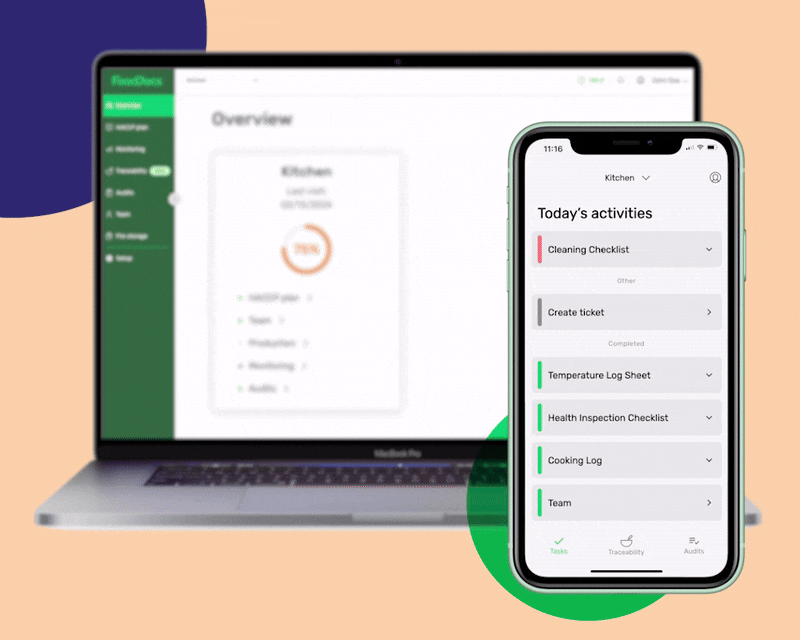
Specifically, you can help your team through the following services that we provide:

Our digital Food Safety Monitoring System can also help you improve efficiency when it comes to managing food safety in your food company:
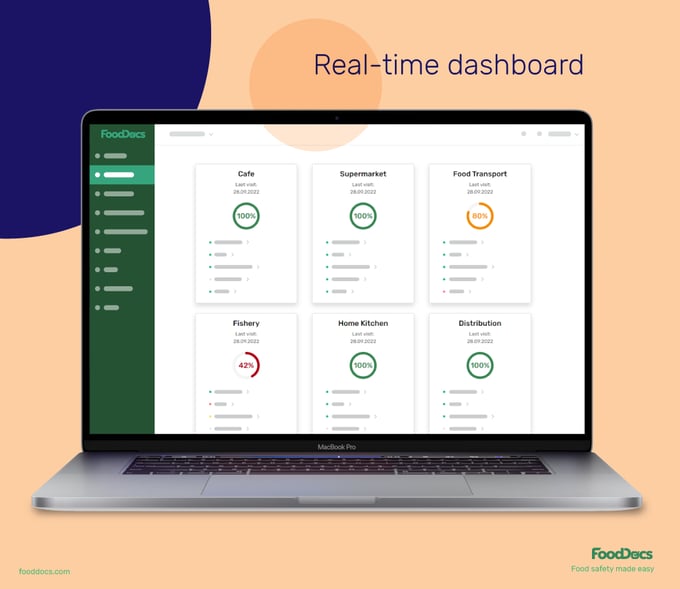
Building your comprehensive digital FSMS can be as easy as a few clicks. Powered by artificial intelligence and a machine-learning program, our system can generate your food safety system in just 15 minutes. Moreover, you can further customize the system to fit unique operations in your food establishment.
Start your food safety compliance journey in a digital platform with us at FoodDocs. Experience our digital FSMS by using our free 14-day trial now.
Learn challenges healthcare foodservice teams face today and key food safety practices to protect vulnerable patients. Get a free healthcare leader...
Learn what Standard Operating Procedures (SOPs) are and how to write effective SOPs that ensure consistency, efficiency, and safety in your...
Boost your retail food safety with essential practices and digital tools to protect customers and your brand. Plus a free Retail Food Safety Leader...